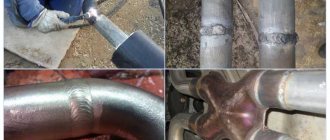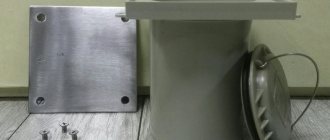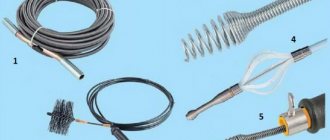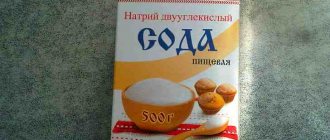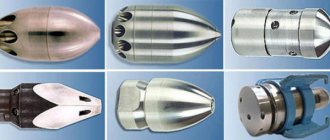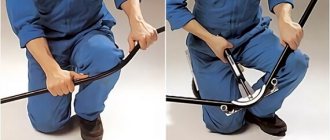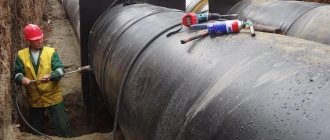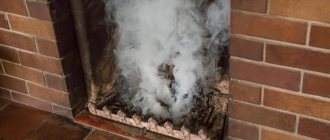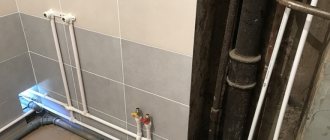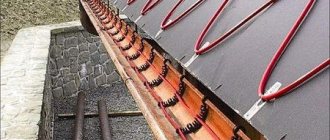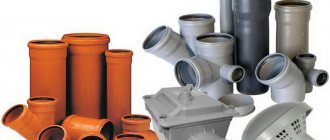A blockage in a private house, apartment or public building is a big nuisance. Often, problems with sewerage require prompt and quick resolution and the presence of competent professionals.
Procedures for cleaning pipelines are carried out upon completion of the process of installing a special device and supplying process water under pressure. Experts select a device depending on the type of deposit.
All cleaning operations are carried out after agreement with the customer. The cleaning is controlled by a special body - technical supervision with independent representatives of construction control.
Promotions and discounts
#tab_container_2861 { overflow:hidden; display:block; width:100%; border:0px solid #ddd; margin-bottom:30px; } #tab_container_2861 .tab-content{ padding:20px; border: 1px solid #e6e6e6 !important; margin-top: 0px; background-color:#ffffff !important; color: #000000 !important; font-size:15px !important; font-family: Helvetica !important; border: 1px solid #e6e6e6 !important; } #tab_container_2861 .wpsm_nav-tabs { border-bottom: 0px solid #ddd; } #tab_container_2861 .wpsm_nav-tabs > li.active > a, #tab_container_2861 .wpsm_nav-tabs > li.active > a:hover, #tab_container_2861 .wpsm_nav-tabs > li.active > a:focus { color: #000000 !important ; cursor: default; background-color: #ffffff !important; border: 1px solid #e6e6e6 !important; } #tab_container_2861 .wpsm_nav-tabs > li > a { margin-right: 0px !important; line-height: 1.42857143 !important; border: 1px solid #e8e8e8 !important; border-radius: 0px 0px 0 0 !important; background-color: #fbfbfb !important; color: #000000 !important; padding: 15px 18px 15px 18px !important; text-decoration: none !important; font-size: 15px !important; text-align:center !important; font-family: Helvetica !important; } #tab_container_2861 .wpsm_nav-tabs > li > a:focus { outline: 0px !important; } #tab_container_2861 .wpsm_nav-tabs > li > a:before { display:none !important; } #tab_container_2861 .wpsm_nav-tabs > li > a:after { display:none !important ; } #tab_container_2861 .wpsm_nav-tabs > li{ padding:0px !important ; margin:0px; } #tab_container_2861 .wpsm_nav-tabs > li > a:hover , #tab_container_2861 .wpsm_nav-tabs > li > a:focus { color: #000000 !important; background-color: #fbfbfb !important; border: 1px solid #e8e8e8 !important; } #tab_container_2861 .wpsm_nav-tabs > li > a .fa{ margin-right:5px !important; margin-left:5px !important; } #tab_container_2861 .wpsm_nav-tabs a{ background-image: none; background-position: 0 0; background-repeat: repeat-x; } #tab_container_2861 .wpsm_nav-tabs > li { float: left; margin-bottom: -1px !important; margin-right:0px !important; } #tab_container_2861 .tab-content{ overflow:hidden !important; } @media (min-width: 769px) { #tab_container_2861 .wpsm_nav-tabs > li{ float:left !important ; margin-right:-1px !important; } #tab_container_2861 .wpsm_nav-tabs{ float:none !important; margin:0px !important; } #tab_container_2861 .wpsm_nav-tabs > li { } #tab_container_2861 .wpsm_nav{ } } @media (max-width: 768px) { #tab_container_2861 .wpsm_nav-tabs > li { } #tab_container_2861 .wpsm_nav{ } } .wpsm_nav-tabs li :before{ display:none !important; } @media (max-width: 768px) { #tab_container_2861 .wpsm_nav-tabs li ai{ display: none !important; } .wpsm_nav-tabs{ margin-left:0px !important; margin-right:0px !important; } #tab_container_2861 .wpsm_nav-tabs > li{ float:none !important; } }
- Payment Methods
- Promotions and discounts
Sberbank
VISA cards
MasterCard
Maps WORLD
For Jur. persons
- 50% for the provision of the second service
- 50% for processing the second apartment
- 10% for holders of a Muscovite social card
jQuery(function () { jQuery('#myTab_2861 a:first').tab('show') }); "}" data-sheets-userformat='{"2″:14851,"3":{"1″:0},"4″:[NULL,2,14281427],"12″:0,"14″ :[NULL,2,0],»15″:»Roboto»,»16″:10}'>
Promotions and discounts
- Payment Methods
- Promotions and discounts
Sberbank
VISA Cards
MasterCard
Maps WORLD
For Jur. persons
- 50% for the provision of the second service
- 50% for processing the second apartment
- 10% for holders of a Muscovite social card
Who needs cleaning and why?
Sewage systems are an integral part of cottages and multi-storey buildings. They must be installed at public service facilities. Sewage systems are used by employees of industrial companies.
Without such communication, it is difficult to imagine how a whole range of production processes will be carried out. The sewer system requires regular maintenance. For its normal operation, maintaining communications in good condition, flushing the pipeline is used. The optimal option for cleaning communications is selected by specialists.
Types of pollution
Contaminants form on the inner surface of pipelines as a result of the operation of structures. During use, all kinds of deposits are formed on the pipe walls: soap, fatty acids, hydrocarbons, impurities of all kinds of mechanical impurities, wax, burnt vegetable and animal fats, mineral deposits, fuel oil, etc.
Any deposit can be cleaned either independently or by professional companies. But all contaminants in the pipeline must be removed.
Why should pipelines be cleaned for any contamination?
There are such blockages when it is necessary to take emergency cleaning measures in order to restore the functioning of critical communication systems. However, partial contamination of worker threads can also lead to big troubles:
- Accumulation of contaminants in pipes, preventing rapid drainage.
- The appearance of noise.
- The penetration of rust and other mechanical impurities from the water supply system into food and drinks.
- Scale formation, the danger of which is the formation of harmful bacteria and microorganisms.
- Reducing the performance of the heating system by reducing the diameter of the pipes.
Such troubles cannot be ignored - they must be eliminated. The appropriate technique is selected depending on the type and complexity of the problem.
Deposits on the inner surface of the pipeline
During the operation of main oil pipelines and product pipelines, many different types of mechanical impurities accumulate inside the pipes - rust, scale, sand, water, ceresins, asphalgens, resinous substances, and so on, which reduce the quality of oil and petroleum products, wear out pipes and clog shut-off valves, leading to wear flange connections.
Types of cleaning
Pipelines are cleaned of various contaminants using mechanical, thermal, ultrasonic and chemical influences. Let's consider each method separately.
Mechanical cleaning is carried out using cleaning machines, sandblasting or shot blasting at facilities that exclude automated methods. For mechanical cleaning, the choice of technological mode is more important. When carrying out the procedure for cleaning pipelines mechanically, you cannot do without the use of a plunger, brush, wire and plumbing cable.
Chemical cleaning of the sewer system involves treating pipes with acidic and alkaline aqueous solutions. This method is ideal for carrying out in a factory environment. To remove deposits, aqueous solutions of hydrochloric, phosphoric and sulfuric acid are used. In some cases, the chemical option for cleaning the sewer system is the only possible method of getting rid of blockages and all kinds of deposits.
With the ultrasonic method of removing contaminants, a pipe with a certain vibration frequency is placed in a liquid medium. As a result of the impact of hydraulic shock, the surface of the pipelines is cleaned. Ultrasonic cleaning is often combined with chemical cleaning - this gives a great effect in stationary conditions.
In the thermal method, pipes are heated by a flame of an oxygen-gas mixture. When carrying out the procedure, semi-ring PKH burners are used. As a result of this impact, the surface layer of contaminants burns out. Upon completion of the cleaning procedure, mechanical cleaning is used with a special set of tools.
Self-cleaning
Before cleaning, the condition of the pipelines should be assessed. Old pipes should not be touched, but it is permissible to treat contaminants chemically. The cleaning method is selected based on the length of the pipe, the location of the blockage, the type of installation and the possibility of disconnecting the pipeline from the main. So, let's look at ways to clean it yourself:
- Tapping with a hammer. Here the pipe should not be disassembled. It is necessary to lightly tap the pipe with a tool and open the tap to drain the water. The system should be tapped partially, not all at once. Otherwise, there is a risk that the sewer system will become completely clogged.
- Flexible cable. First of all, the access to water is blocked. Then you will need to dismantle the tap, mixer and any threaded fittings. Next, a flexible cable is inserted into the hole, twisted and removed with rotation. The water is opened to flush out the blockage, and the fittings are reinstalled.
- Solutions of household chemicals. In order to clean the pipeline using this method, a special liquid is poured into the water supply system for 2-3 hours. After the specified period of time, it is necessary to open the water pressure to full capacity. Remember that this type of cleaning can pose a threat to human health if the special solution lingers inside the pipeline.
- Dismantling is the last resort for cleaning pipelines. You can try dismantling if all the above methods were in vain, and the pipe is assembled on threaded fittings. During dismantling, the water is turned off and parts of the pipeline are unscrewed. Next, using a hose, liquid under pressure is supplied and the hole is washed.
All of the above methods for cleaning pipelines are applicable exclusively to new systems. If communications have a long service life, then it is better to refrain from cleaning the sewer yourself, because these devices have a high degree of wear and tear. For this reason, force and chemical exposure can destroy communication. Remember that in some cases, independent intervention can lead to worsening of the blockage.
How to flush the system - 3 available methods
Without the use of specialized equipment, you can do the washing in the following ways:
Reference. Centralized heating networks of apartment buildings are flushed using the hydropneumatic method. A powerful compressor is connected to the elevator unit located in the heating point. A mixture of water and air is pumped through the radiators and pipes of all apartments, tearing off particles of solid deposits, and even more so silt. The dirt is then dumped into the sewer.
Most homeowners do not have compressor units. In addition, you will need a mixing chamber and experience in performing such activities, otherwise you risk breaking the tightness of the joints. This means that the hydropneumatic method is of little use for self-flushing the system. We recommend starting by cleaning dead batteries.
Radiator cleaning
Identifying a problem battery is quite simple - with the heating running, feel the entire surface with your hand or measure the temperature at different points with a contact/non-contact thermometer, and then compare with the temperature of the supply line. If the sections heat up unevenly, flush the radiator.
In an apartment with central heating, flushing the battery is done as follows:
- We close the shut-off valves on the connections to the heating device. Using a gas wrench, unscrew the top plug with the Mayevsky tap, substitute the basin, and drain part of the coolant.
- Carefully open the tap on the supply line so that the water pressure throws debris out of the radiator. Of course, keep your basin under the stream. When the light coolant flows out, close the valve and put the plug in place.
- Similarly, we repeat the listed manipulations with the bottom plug. After rinsing, tighten the plug, open both taps, and bleed the air.
The described technology is applicable in private houses with automatic heating from the water supply. Just before flushing, it is better to close the valves on the boiler and expansion tank. In other cases, you need to remove the radiator and wash it separately. Connecting a cold water supply hose to the heating network is a risky option; when water is supplied “to a closed valve”, high pressure of 3...6 Bar can break the tightness of the system.
Disconnecting the battery gives one plus - the opportunity to look inside the supply pipes. Having seen deposits there that cover 1/3 or half of the flow area, it is easy to decide on further flushing of all heating pipelines.
Note. In an open system we have an expansion tank communicating with the atmosphere. If it is not possible to cut off the container with a tap, then it will not be possible to flush the battery through the recharge; the water will trample over the top and begin to drown the house.
Cast iron radiators that have served for more than 10 years will definitely have to be removed and cleaned with some kind of chemical, for example, a caustic soda solution (see the video below). The sediment at the bottom of each section rarely remains liquid and is unlikely to be removed using running water.
Rinsing with running water
The essence of the method is to remove dirt from the system using a large flow of water from the centralized water supply network. Let us immediately note the disadvantage of this option: only liquid sludge and suspended particles traveling along with the coolant can be washed out of pipes and heating appliances. If there are hard deposits in the batteries, it will not be possible to remove them.
How is this hydroflushing done:
- We connect the water supply hose to the make-up fitting. As you know, this pipe is cut into the lower point of the heating return line. We connect the drain hose to a break in the supply line (for example, instead of a circulation pump or at the junction of a faucet) and lead it to the sewer or to an area near the house.
- We clean the mud trap, open all radiator taps and balancing valves.
- The boiler must be isolated from the system using taps and must be washed separately. You should not drive all the dirt through its heat exchangers, especially for double-circuit heat generators.
- Open the water valve, gradually increasing the water flow. As you understand, backwashing begins, that is, the flow moves towards the coolant flow in operating mode.
- When the stream from the drain hose becomes transparent, turn off the water, swap the hoses and flush the heating in the other direction - along the movement of the coolant.
- At the end of the hydraulic cleaning, we refill the system, start the boiler, check the operation of the batteries and do balancing.
An important nuance. It should be understood that flushing is carried out due to the high flow of water through the heating pipelines, and not due to high pressure. You cannot supply water “to a closed valve”, only through an open drain hose. The heating network is not designed for water pressure.
A system with an open tank must first be prepared for flow rinsing. There are 2 options: cut off the expansion tank with a tap or plug the overflow tube. The second method is suitable for tanks without a top cover. If this is not done, the water will overfill the tank and flow out, leaving the area of the system left unwashed.
Chemical cleaning option
This is the most affordable way to thoroughly flush the heating system with your own hands.
To implement it you will need:
- vibration pump of a submersible household series, for example, “Rucheek” (or similar);
- a water filter in the form of a flask with 2–3 replaceable cartridges;
- special means for flushing heating networks and radiators;
- container for chemical solution;
- connecting fittings.
The procedure is carried out in 3 stages - preliminary removal of contaminants with running water, then chemical cleaning itself, and finally - final rinsing. The first and third stages are done using the technology described above using water supply; the second stage uses a submersible pump and filter.
How to flush the heating system chemically (stage 2):
- Prepare the washing solution in the barrel according to the instructions on the package. The amount of liquid corresponds to the volume of coolant in the heating network plus the container itself. We wrote how to choose the right chemical at the end of the article.
- Connect the pressure pipe of the pump to the heating supply, immerse the device in the barrel. The filter is placed on the drain line, which is directed into the same container, as shown in the video below.
- Remove the mesh from the standard mud pan and screw the empty plug back on. Otherwise you will have to clean it every 10 minutes.
- Turn on the pump, pump the reagent into the system. Make sure that the solution flows into the barrel from the drain hose and that there are no leaks.
- Flush heating lines until the water stream becomes lighter. Heavily contaminated filter cartridges must be replaced during the cleaning process.
- Wash the remaining chemicals from the radiator network with running water (stage 3).
Reminder. Chemical cleaning should only affect pipes, radiators and heated floors (if necessary). It is not recommended to pump the reagent through the boiler; it is better to clean the unit separately. An open type expansion tank should be cut off from the pipeline network or sealed.
Professional cleaning
The plumbing system needs constant cleaning. If a homeowner successfully gets rid of one blockage, this does not mean that he has cleared the entire line. The use of a plunger, flexible plumbing cable or household chemicals can remove deposits, but these methods are not able to clean up the entire pipe flow.
At the same time, professional procedures will bring the pipeline into proper condition, which will fully comply with technical standards and requirements and restore the pipeline flow.
Professional Pipeline Cleaning Techniques
In order to effectively professionally clean the water supply system, special equipment is used, and well-trained craftsmen are involved in the work. Experts use three methods in the pipe cleaning procedure.
- Hydrodynamic method using a special machine operating on the following principle: water enters the pipeline. As a result, every deposit on the walls of the water supply surface is removed.
- Thermal, thermochemical method. Water flows inside the pipeline, heated to a temperature of 95-120 degrees. Hot water dissolves every deposit.
- Pneumohydropulse cleaning of pipelines. During the cleaning process, a special pneumatic pulse device is used, with the help of which the water supply is effectively cleaned of dirt and scale.
Uninterrupted operation of the sewer system contributes to the comfort of all residents of the house. But in order to avoid problems, the highway should be maintained on time. It is recommended to seek sewer system cleaning services from professional companies once a year.
When is heating flushed?
Let us immediately note that individual heating systems of apartments and country houses very rarely require flushing. Typically, deterioration in heating is associated with other reasons, for example, airing.
Heat loss calculator
Calculator for the number of radiator sections
Heated floor calculator
Let's explain:
- You filled the network with fresh water or antifreeze, expelled the air, and started the boiler.
- After 2-3 weeks, the coolant “breaks in” - a precipitate of salts falls in the heat exchanger, solid particles are captured by a mesh filter. During this period, the mud trap needs to be cleaned frequently.
- Since the amount of impurities in the supply water is limited, sedimentation soon stops. There is simply nothing for heat exchangers, pipes and batteries to become clogged with.
That is, a closed system can work quietly without any cleaning. If it is constantly fed from the water supply network, the amount of salt sediment will increase indefinitely. Over the years, the pipelines will become half overgrown, and silt will settle in the radiators.
A similar effect occurs due to the penetration of oxygen into the coolant. Air bubbles cause corrosion of metal pipes and fittings from the inside, forming iron oxide (rust) particles, which are constantly found in the mud pan. The cause may be low-quality plastic pipes without a protective oxygen barrier.
Reference. A “used-in” coolant often takes on a dark or even black color; this is quite normal. Brown water indicates a large amount of rust.
So, in what cases is heating flushing carried out:
- The heating devices, one or more, stopped heating normally. The battery sections heat up unevenly, the bottom remains cold. At the same time, you eliminated all possible faults, but did not get any results.
- For various reasons, you constantly replenish the system with fresh coolant. For example, to operate electrode boilers you need water with a certain amount of salts, which decompose during a chemical reaction. You have to add salt to the coolant or fill in a new one.
- Oxygen penetrates into the network water, the filter often gets clogged (almost every day), the radiators do not heat well, the boiler operates at maximum mode.
The conclusion is simple: flushing is done when there is a problem with the water heating system; no frequency needs to be observed. There is a different approach to the centralized heat supply of multi-apartment residential buildings, where the radiator network is flushed annually, after which pressure testing is performed (in accordance with the requirements of SNiP).
Our advantages
You can order sewer cleaning services from the Sanepidemiological Station Moscow company. By contacting us, you will find a solution to your problem. Advantages of SES Moscow:
- Professional problem solving.
- All activities of the company are regulated by law.
- Carrying out preventive measures.
- Affordable prices.
- Choosing effective work methods.
- Study of the modern market and analysis of consumer power.
- Cooperation with reliable manufacturers.
- Analysis of the latest developments.
- Professional and experienced team.
- Resolution of issues 100%.
Contact the specialists of SES Moscow for high-quality pipeline cleaning services. Our company strives to make your life convenient and comfortable.
SES company specialists will identify the problem and do everything possible to prevent the unpleasant situation from happening again in the future. We use reliable, accurate and state-of-the-art equipment that helps us effectively solve any sewer problem. We will clean pipelines of even the most complex configuration, regardless of the length and size of the pipes. The SES company guarantees maximum safety and effectiveness of the methods used in the company.
